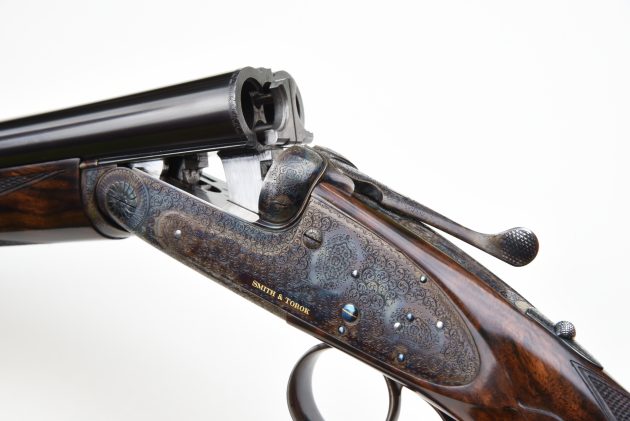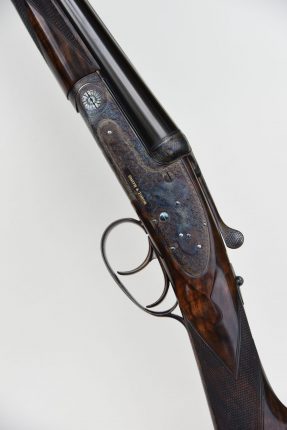On a mission to produce Best London guns at an attainable price, these masters of the gun trade have already produced a stunning .410 and now present an impeccable pair of 28-bores, says Michael Yardley
Smith & Torok 28-bore side-by-side sidelock
SMITH & TOROK 28-BORE SIDE-BY-SIDE SIDELOCK

This review focuses on a pair of Smith & Torok 28-bore side-by-side sidelocks. Weighing a fraction under 6lb each, they are 30in self-opening guns based on the Purdey system made by Alex Torok, whose delightful .410 double we reviewed in the November 2021 issue. It would be hard to better the .410, one of the best small-bores we have yet reviewed in The Field, but first impressions of the 28-bores are nevertheless good; their form and tasteful decoration are immediately pleasing.
The action bars – which have been filed up by hand from forgings – are slim and rounded. They have traditional bonemeal colour case-hardening by Ray St Ledger (also seen on the fore-end iron). Eight pins are visible on each lock (some with tops hot blued, others polished) as well as a gold-lined cocking indicator. The engraving, tight rose and scroll, is by Martin Smith and is beautifully executed. The Smith & Torok name is inlaid in gold on each lockplate, and the guns are numbered in gold too. The finish of the guns, for which David Sinnerton, another master, has been responsible, is first class.
It is at once apparent that these are Best London guns and no corners have been cut. Torok himself filed up the actions; this is good to see as more and more guns, even Best-quality ones, have CNC-machined actions now. Here, everything is done in old-school fashion by bench craftsmen. The only concession to modernity concerns the mainsprings, which are of V form but have been wire cut rather than bent and tempered in traditional manner. Torok even made the accompanying oak-and-leather double case.
The barrels, made by the late Mike Smith, are well presented, with first-class striking-up and fine internal finish. A traditional brass bead well proportioned to the small tubes is fitted at the muzzles. Choking is fixed and tight – full and full – so, as configured, the guns would not be suitable for steel shot (the choke constriction would require reduction). This is a difficult subject for the users of small-bore guns now, as they have fewer non-toxic options – essentially, it’s lead or, maybe, bismuth (steel for small-bores remains unproven – reduced shell case volume creates issues with larger shot).
The stock here is the work of Ian Smith (another ex-Purdey man). The shapes are Purdey with a straight English grip of oval cross-section, drop points and steel heel and toe pieces (an addition to the standard specification). The Turkish walnut is especially well figured and described as ‘exhibition quality’ by the maker. It was good to see straightish grain going through the grip area, which is subject to significant stresses. My own inclination is usually to avoid overly showy wood in working guns as it may be weaker. When you look at vintage English guns from great makers they rarely have an elaborate figure in their butts, yet many of these guns have survived without restocking for a hundred years or more.

Torok told me the challenge of making the 28-bore action was not quite as great as his .410 because the barrel centres are wider spaced, creating fewer problems accommodating the ejector work and self-opening mechanism. He was also keen to explain that his mission is to produce truly Best-quality London guns at a still attainable price. At £60,000 plus VAT each, the test guns are about half the cost of the biggest names.
What of the 28-bore itself? It does not have the versatility of the 12- or 20-bore, but in capable hands, it will do almost all they can and bring a smile to the user’s face. For instructional purposes, light loads in a 20-bore may be better now (and a lot more affordable), but with 23g, 25g or even 28g (in heavier guns), the 28-bore is a surprisingly effective game gun.
TECHNICAL
A Purdey/Beesley-style gun cocks on opening, unlike a Holland & Holland, which cocks on closing. One mainspring limb powers the tumbler, the other the self-opening feature. It’s a beautiful system, but complex and not as much copied as the Holland design. Here, though, it is impeccably presented. The Smith & Torok has the ubiquitous Purdey double lumps, and the action also has a hardened steel insert (as recent Purdeys) bearing on the circle of the back lump to increase longevity by decreasing pressure on the cross-pin. The gun has Purdey-style ejection as well. When the gun is fired, an ejector rod is pushed through the action body by the tumbler (hammer) into the fore-end iron, engaging a small side spring that is supporting the primary ejector V-spring. This last engages the ejector cam, and, as the gun is opened, the cam rotates further, allowing this spring to suddenly release its tension, powering the ejector(s).
SHOOTING IMPRESSIONS
I am a fan of 28-bores. They have excellent ballistics (at least with lead) and typically benefit from lightness if not taken to extremes. The downside is the availability and cost of cartridges. Many enthusiasts won’t be deterred, however. The 28-bore is the gun of choice for quail in the USA. It can be an excellent and practical pigeon gun too – if you can suffer the cartridge cost. The test guns shot admirably. The balance was a little forward, which steadied them. I found myself using the front hand and upper body more to push on. I had no issues bar one trigger being a bit light. Sound stock shapes aided control and recoil was no issue. The Purdey-style oval grip provided purchase, although quite slim. All good. We will hear more from Smith & Torok. So far, 15 guns, including six 28-bores, carry the name.
PRODUCT DETAILS
SMITH & TOROK 28-BORE SIDE-BY-SIDE
♦ RRP: £60,000 plus VAT
♦ Smith & Torok, Henfield, West Sussex
♦ 07886 531569




